Management Accounting Report: Analysis of Costing and Reporting
VerifiedAdded on 2020/06/06
|18
|4721
|34
Report
AI Summary
This report provides a comprehensive overview of management accounting principles, focusing on costing methods, reporting systems, and their application within a business context. The report begins with definitions and the importance of management accounting, differentiating it from financial accounting, and highlighting its role in strategic management, performance appraisal, and risk reduction. It then explores various management accounting systems, including cost accounting, inventory management, and job costing, detailing their advantages and applications. The report further analyzes managerial accounting reports such as budget reports, accounts receivable reports, and job cost reports, emphasizing their significance in decision-making, loss reduction, and financial return enhancement. The report also covers different costing methods like marginal costing and absorption costing, with an example of an income statement prepared using the marginal costing method. The case study of Tech (UK) Limited is used to illustrate the practical application of these concepts, providing a well-rounded understanding of management accounting and its impact on business operations.
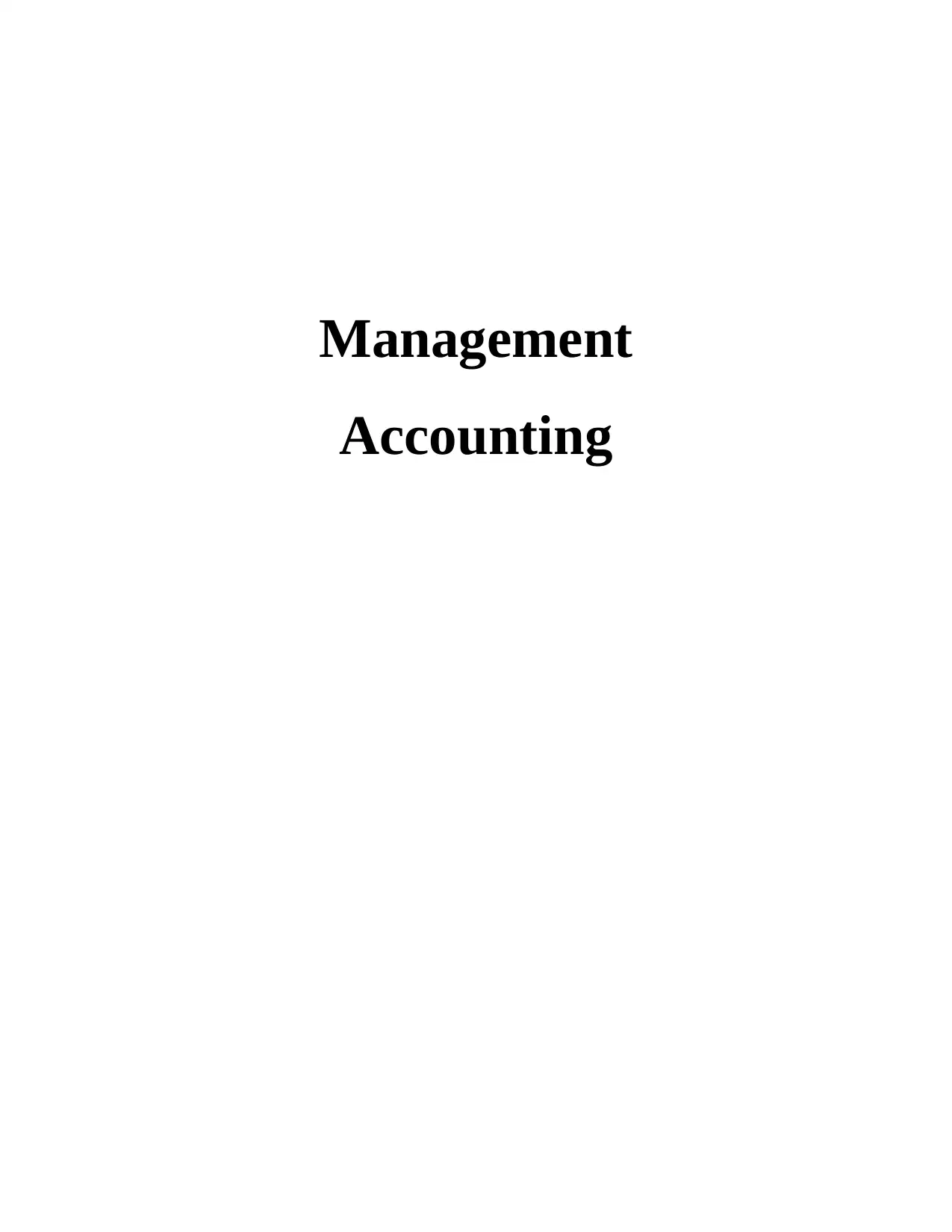
Management
Accounting
Accounting
Paraphrase This Document
Need a fresh take? Get an instant paraphrase of this document with our AI Paraphraser
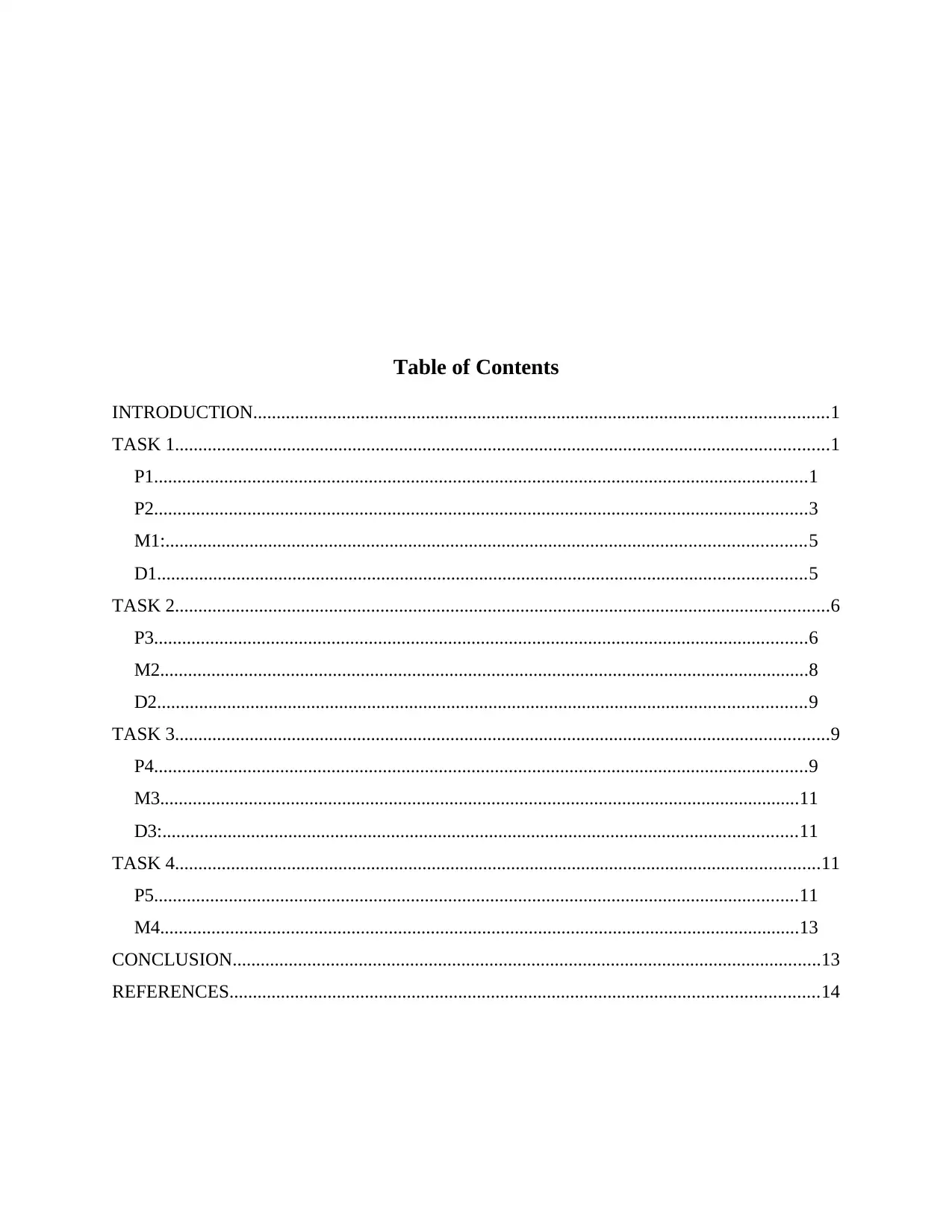
Table of Contents
INTRODUCTION...........................................................................................................................1
TASK 1............................................................................................................................................1
P1............................................................................................................................................1
P2............................................................................................................................................3
M1:.........................................................................................................................................5
D1...........................................................................................................................................5
TASK 2............................................................................................................................................6
P3............................................................................................................................................6
M2...........................................................................................................................................8
D2...........................................................................................................................................9
TASK 3............................................................................................................................................9
P4............................................................................................................................................9
M3.........................................................................................................................................11
D3:........................................................................................................................................11
TASK 4..........................................................................................................................................11
P5..........................................................................................................................................11
M4.........................................................................................................................................13
CONCLUSION..............................................................................................................................13
REFERENCES..............................................................................................................................14
INTRODUCTION...........................................................................................................................1
TASK 1............................................................................................................................................1
P1............................................................................................................................................1
P2............................................................................................................................................3
M1:.........................................................................................................................................5
D1...........................................................................................................................................5
TASK 2............................................................................................................................................6
P3............................................................................................................................................6
M2...........................................................................................................................................8
D2...........................................................................................................................................9
TASK 3............................................................................................................................................9
P4............................................................................................................................................9
M3.........................................................................................................................................11
D3:........................................................................................................................................11
TASK 4..........................................................................................................................................11
P5..........................................................................................................................................11
M4.........................................................................................................................................13
CONCLUSION..............................................................................................................................13
REFERENCES..............................................................................................................................14
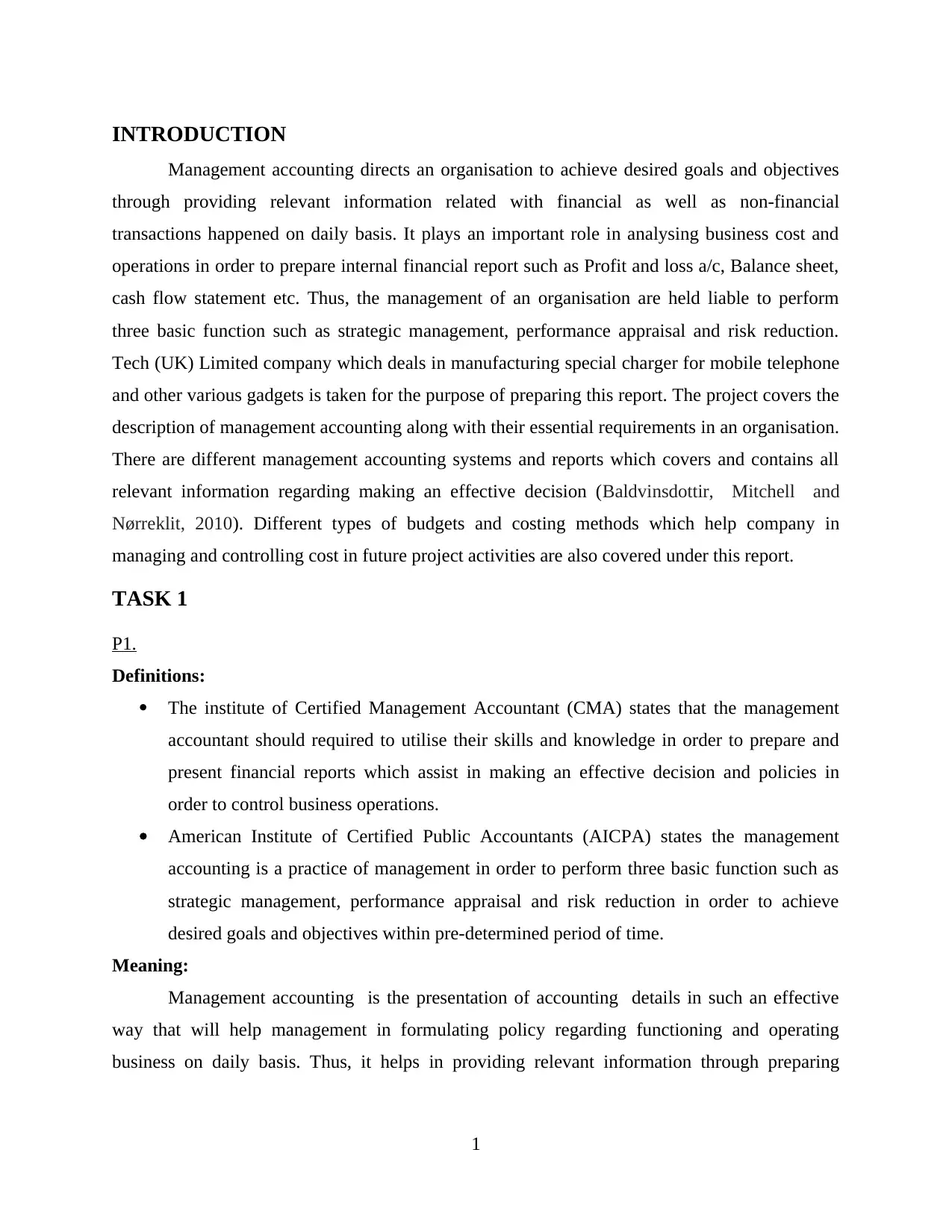
INTRODUCTION
Management accounting directs an organisation to achieve desired goals and objectives
through providing relevant information related with financial as well as non-financial
transactions happened on daily basis. It plays an important role in analysing business cost and
operations in order to prepare internal financial report such as Profit and loss a/c, Balance sheet,
cash flow statement etc. Thus, the management of an organisation are held liable to perform
three basic function such as strategic management, performance appraisal and risk reduction.
Tech (UK) Limited company which deals in manufacturing special charger for mobile telephone
and other various gadgets is taken for the purpose of preparing this report. The project covers the
description of management accounting along with their essential requirements in an organisation.
There are different management accounting systems and reports which covers and contains all
relevant information regarding making an effective decision (Baldvinsdottir, Mitchell and
Nørreklit, 2010). Different types of budgets and costing methods which help company in
managing and controlling cost in future project activities are also covered under this report.
TASK 1
P1.
Definitions:
The institute of Certified Management Accountant (CMA) states that the management
accountant should required to utilise their skills and knowledge in order to prepare and
present financial reports which assist in making an effective decision and policies in
order to control business operations.
American Institute of Certified Public Accountants (AICPA) states the management
accounting is a practice of management in order to perform three basic function such as
strategic management, performance appraisal and risk reduction in order to achieve
desired goals and objectives within pre-determined period of time.
Meaning:
Management accounting is the presentation of accounting details in such an effective
way that will help management in formulating policy regarding functioning and operating
business on daily basis. Thus, it helps in providing relevant information through preparing
1
Management accounting directs an organisation to achieve desired goals and objectives
through providing relevant information related with financial as well as non-financial
transactions happened on daily basis. It plays an important role in analysing business cost and
operations in order to prepare internal financial report such as Profit and loss a/c, Balance sheet,
cash flow statement etc. Thus, the management of an organisation are held liable to perform
three basic function such as strategic management, performance appraisal and risk reduction.
Tech (UK) Limited company which deals in manufacturing special charger for mobile telephone
and other various gadgets is taken for the purpose of preparing this report. The project covers the
description of management accounting along with their essential requirements in an organisation.
There are different management accounting systems and reports which covers and contains all
relevant information regarding making an effective decision (Baldvinsdottir, Mitchell and
Nørreklit, 2010). Different types of budgets and costing methods which help company in
managing and controlling cost in future project activities are also covered under this report.
TASK 1
P1.
Definitions:
The institute of Certified Management Accountant (CMA) states that the management
accountant should required to utilise their skills and knowledge in order to prepare and
present financial reports which assist in making an effective decision and policies in
order to control business operations.
American Institute of Certified Public Accountants (AICPA) states the management
accounting is a practice of management in order to perform three basic function such as
strategic management, performance appraisal and risk reduction in order to achieve
desired goals and objectives within pre-determined period of time.
Meaning:
Management accounting is the presentation of accounting details in such an effective
way that will help management in formulating policy regarding functioning and operating
business on daily basis. Thus, it helps in providing relevant information through preparing
1
⊘ This is a preview!⊘
Do you want full access?
Subscribe today to unlock all pages.

Trusted by 1+ million students worldwide
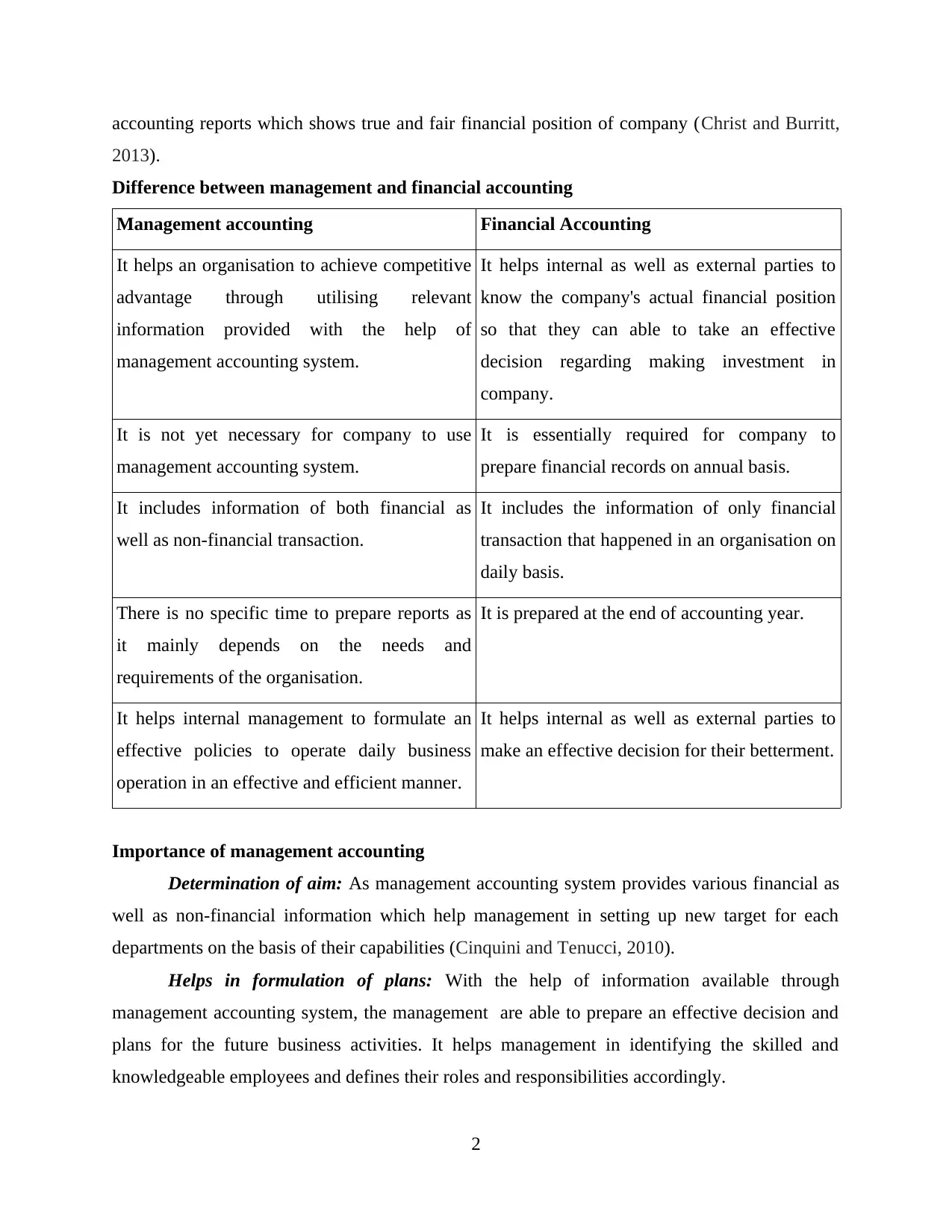
accounting reports which shows true and fair financial position of company (Christ and Burritt,
2013).
Difference between management and financial accounting
Management accounting Financial Accounting
It helps an organisation to achieve competitive
advantage through utilising relevant
information provided with the help of
management accounting system.
It helps internal as well as external parties to
know the company's actual financial position
so that they can able to take an effective
decision regarding making investment in
company.
It is not yet necessary for company to use
management accounting system.
It is essentially required for company to
prepare financial records on annual basis.
It includes information of both financial as
well as non-financial transaction.
It includes the information of only financial
transaction that happened in an organisation on
daily basis.
There is no specific time to prepare reports as
it mainly depends on the needs and
requirements of the organisation.
It is prepared at the end of accounting year.
It helps internal management to formulate an
effective policies to operate daily business
operation in an effective and efficient manner.
It helps internal as well as external parties to
make an effective decision for their betterment.
Importance of management accounting
Determination of aim: As management accounting system provides various financial as
well as non-financial information which help management in setting up new target for each
departments on the basis of their capabilities (Cinquini and Tenucci, 2010).
Helps in formulation of plans: With the help of information available through
management accounting system, the management are able to prepare an effective decision and
plans for the future business activities. It helps management in identifying the skilled and
knowledgeable employees and defines their roles and responsibilities accordingly.
2
2013).
Difference between management and financial accounting
Management accounting Financial Accounting
It helps an organisation to achieve competitive
advantage through utilising relevant
information provided with the help of
management accounting system.
It helps internal as well as external parties to
know the company's actual financial position
so that they can able to take an effective
decision regarding making investment in
company.
It is not yet necessary for company to use
management accounting system.
It is essentially required for company to
prepare financial records on annual basis.
It includes information of both financial as
well as non-financial transaction.
It includes the information of only financial
transaction that happened in an organisation on
daily basis.
There is no specific time to prepare reports as
it mainly depends on the needs and
requirements of the organisation.
It is prepared at the end of accounting year.
It helps internal management to formulate an
effective policies to operate daily business
operation in an effective and efficient manner.
It helps internal as well as external parties to
make an effective decision for their betterment.
Importance of management accounting
Determination of aim: As management accounting system provides various financial as
well as non-financial information which help management in setting up new target for each
departments on the basis of their capabilities (Cinquini and Tenucci, 2010).
Helps in formulation of plans: With the help of information available through
management accounting system, the management are able to prepare an effective decision and
plans for the future business activities. It helps management in identifying the skilled and
knowledgeable employees and defines their roles and responsibilities accordingly.
2
Paraphrase This Document
Need a fresh take? Get an instant paraphrase of this document with our AI Paraphraser
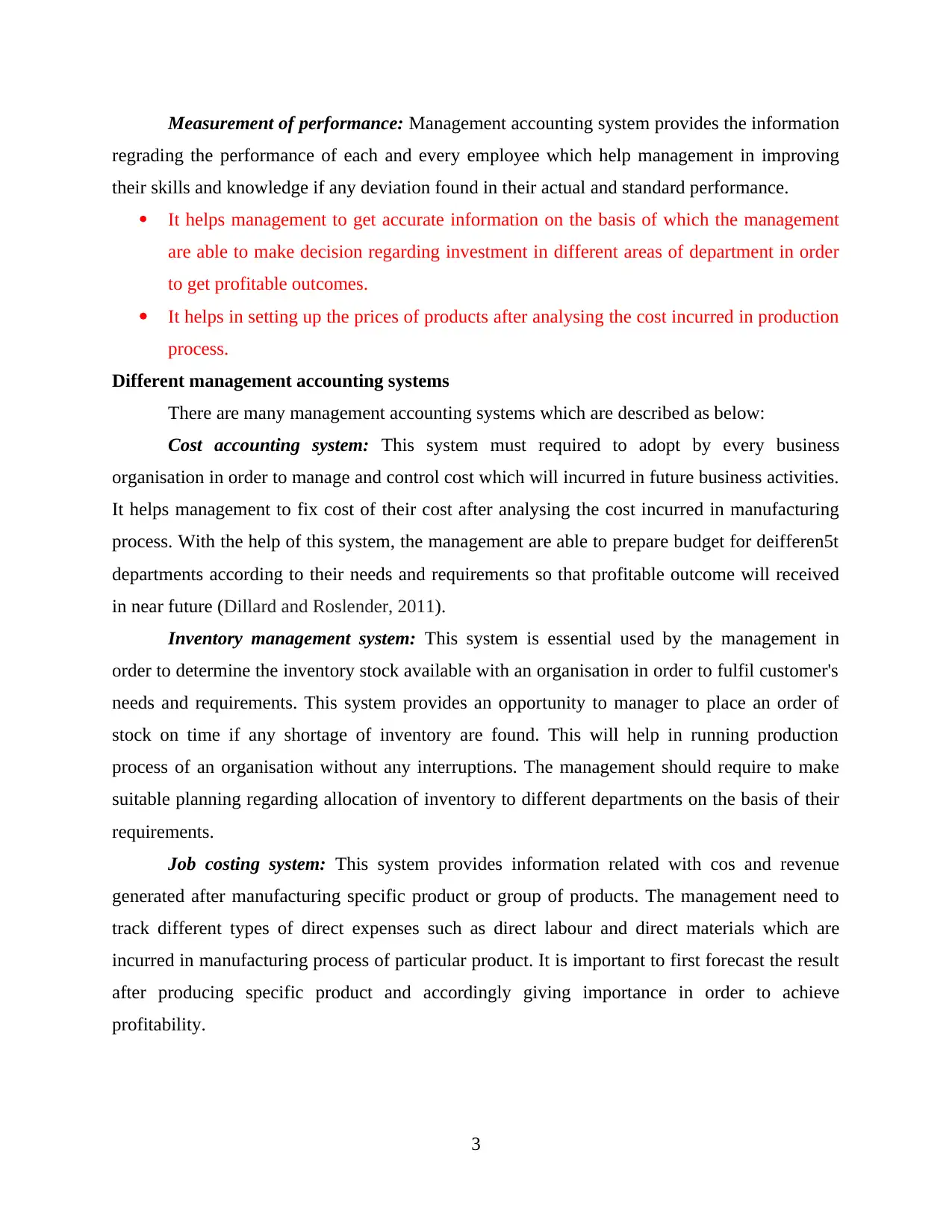
Measurement of performance: Management accounting system provides the information
regrading the performance of each and every employee which help management in improving
their skills and knowledge if any deviation found in their actual and standard performance.
It helps management to get accurate information on the basis of which the management
are able to make decision regarding investment in different areas of department in order
to get profitable outcomes.
It helps in setting up the prices of products after analysing the cost incurred in production
process.
Different management accounting systems
There are many management accounting systems which are described as below:
Cost accounting system: This system must required to adopt by every business
organisation in order to manage and control cost which will incurred in future business activities.
It helps management to fix cost of their cost after analysing the cost incurred in manufacturing
process. With the help of this system, the management are able to prepare budget for deifferen5t
departments according to their needs and requirements so that profitable outcome will received
in near future (Dillard and Roslender, 2011).
Inventory management system: This system is essential used by the management in
order to determine the inventory stock available with an organisation in order to fulfil customer's
needs and requirements. This system provides an opportunity to manager to place an order of
stock on time if any shortage of inventory are found. This will help in running production
process of an organisation without any interruptions. The management should require to make
suitable planning regarding allocation of inventory to different departments on the basis of their
requirements.
Job costing system: This system provides information related with cos and revenue
generated after manufacturing specific product or group of products. The management need to
track different types of direct expenses such as direct labour and direct materials which are
incurred in manufacturing process of particular product. It is important to first forecast the result
after producing specific product and accordingly giving importance in order to achieve
profitability.
3
regrading the performance of each and every employee which help management in improving
their skills and knowledge if any deviation found in their actual and standard performance.
It helps management to get accurate information on the basis of which the management
are able to make decision regarding investment in different areas of department in order
to get profitable outcomes.
It helps in setting up the prices of products after analysing the cost incurred in production
process.
Different management accounting systems
There are many management accounting systems which are described as below:
Cost accounting system: This system must required to adopt by every business
organisation in order to manage and control cost which will incurred in future business activities.
It helps management to fix cost of their cost after analysing the cost incurred in manufacturing
process. With the help of this system, the management are able to prepare budget for deifferen5t
departments according to their needs and requirements so that profitable outcome will received
in near future (Dillard and Roslender, 2011).
Inventory management system: This system is essential used by the management in
order to determine the inventory stock available with an organisation in order to fulfil customer's
needs and requirements. This system provides an opportunity to manager to place an order of
stock on time if any shortage of inventory are found. This will help in running production
process of an organisation without any interruptions. The management should require to make
suitable planning regarding allocation of inventory to different departments on the basis of their
requirements.
Job costing system: This system provides information related with cos and revenue
generated after manufacturing specific product or group of products. The management need to
track different types of direct expenses such as direct labour and direct materials which are
incurred in manufacturing process of particular product. It is important to first forecast the result
after producing specific product and accordingly giving importance in order to achieve
profitability.
3
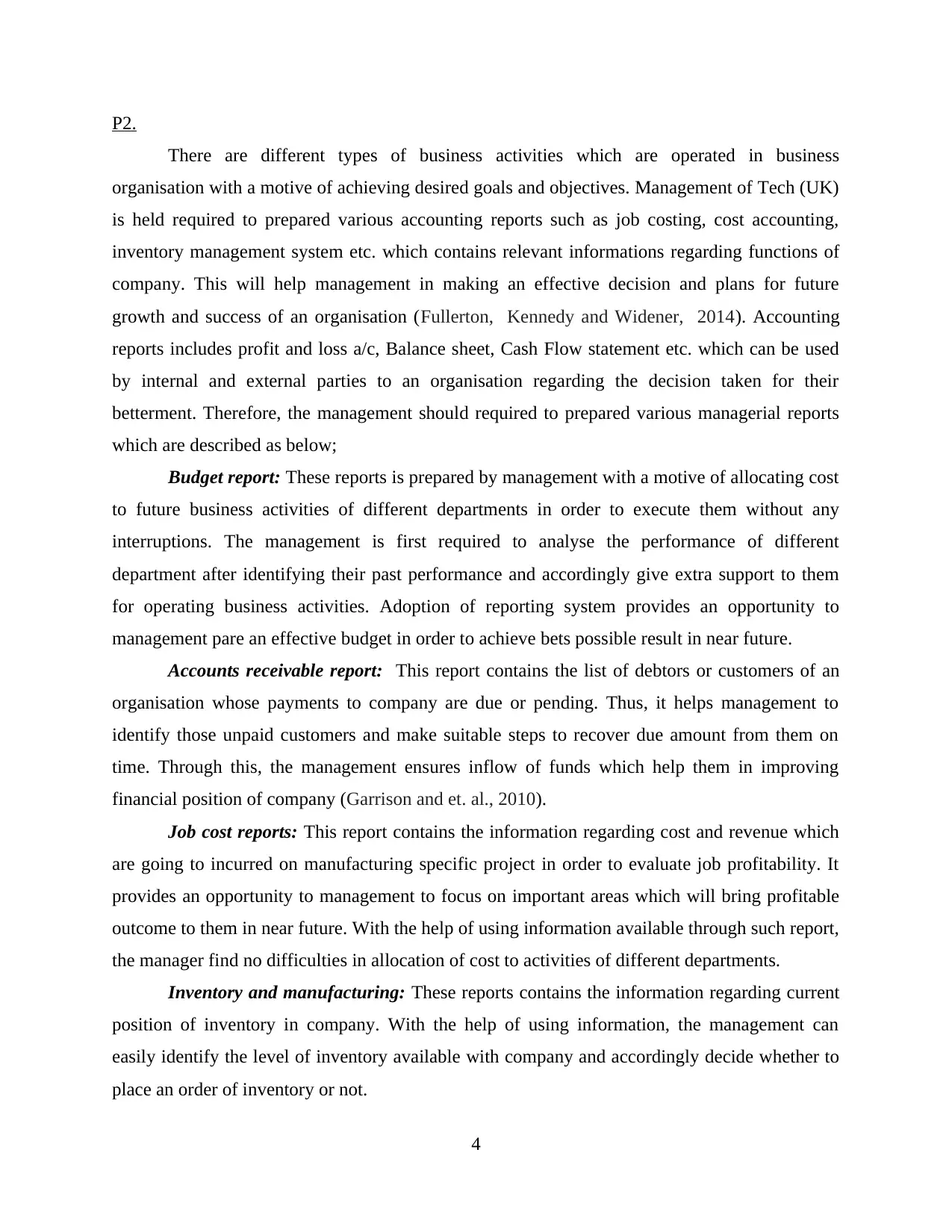
P2.
There are different types of business activities which are operated in business
organisation with a motive of achieving desired goals and objectives. Management of Tech (UK)
is held required to prepared various accounting reports such as job costing, cost accounting,
inventory management system etc. which contains relevant informations regarding functions of
company. This will help management in making an effective decision and plans for future
growth and success of an organisation (Fullerton, Kennedy and Widener, 2014). Accounting
reports includes profit and loss a/c, Balance sheet, Cash Flow statement etc. which can be used
by internal and external parties to an organisation regarding the decision taken for their
betterment. Therefore, the management should required to prepared various managerial reports
which are described as below;
Budget report: These reports is prepared by management with a motive of allocating cost
to future business activities of different departments in order to execute them without any
interruptions. The management is first required to analyse the performance of different
department after identifying their past performance and accordingly give extra support to them
for operating business activities. Adoption of reporting system provides an opportunity to
management pare an effective budget in order to achieve bets possible result in near future.
Accounts receivable report: This report contains the list of debtors or customers of an
organisation whose payments to company are due or pending. Thus, it helps management to
identify those unpaid customers and make suitable steps to recover due amount from them on
time. Through this, the management ensures inflow of funds which help them in improving
financial position of company (Garrison and et. al., 2010).
Job cost reports: This report contains the information regarding cost and revenue which
are going to incurred on manufacturing specific project in order to evaluate job profitability. It
provides an opportunity to management to focus on important areas which will bring profitable
outcome to them in near future. With the help of using information available through such report,
the manager find no difficulties in allocation of cost to activities of different departments.
Inventory and manufacturing: These reports contains the information regarding current
position of inventory in company. With the help of using information, the management can
easily identify the level of inventory available with company and accordingly decide whether to
place an order of inventory or not.
4
There are different types of business activities which are operated in business
organisation with a motive of achieving desired goals and objectives. Management of Tech (UK)
is held required to prepared various accounting reports such as job costing, cost accounting,
inventory management system etc. which contains relevant informations regarding functions of
company. This will help management in making an effective decision and plans for future
growth and success of an organisation (Fullerton, Kennedy and Widener, 2014). Accounting
reports includes profit and loss a/c, Balance sheet, Cash Flow statement etc. which can be used
by internal and external parties to an organisation regarding the decision taken for their
betterment. Therefore, the management should required to prepared various managerial reports
which are described as below;
Budget report: These reports is prepared by management with a motive of allocating cost
to future business activities of different departments in order to execute them without any
interruptions. The management is first required to analyse the performance of different
department after identifying their past performance and accordingly give extra support to them
for operating business activities. Adoption of reporting system provides an opportunity to
management pare an effective budget in order to achieve bets possible result in near future.
Accounts receivable report: This report contains the list of debtors or customers of an
organisation whose payments to company are due or pending. Thus, it helps management to
identify those unpaid customers and make suitable steps to recover due amount from them on
time. Through this, the management ensures inflow of funds which help them in improving
financial position of company (Garrison and et. al., 2010).
Job cost reports: This report contains the information regarding cost and revenue which
are going to incurred on manufacturing specific project in order to evaluate job profitability. It
provides an opportunity to management to focus on important areas which will bring profitable
outcome to them in near future. With the help of using information available through such report,
the manager find no difficulties in allocation of cost to activities of different departments.
Inventory and manufacturing: These reports contains the information regarding current
position of inventory in company. With the help of using information, the management can
easily identify the level of inventory available with company and accordingly decide whether to
place an order of inventory or not.
4
⊘ This is a preview!⊘
Do you want full access?
Subscribe today to unlock all pages.

Trusted by 1+ million students worldwide
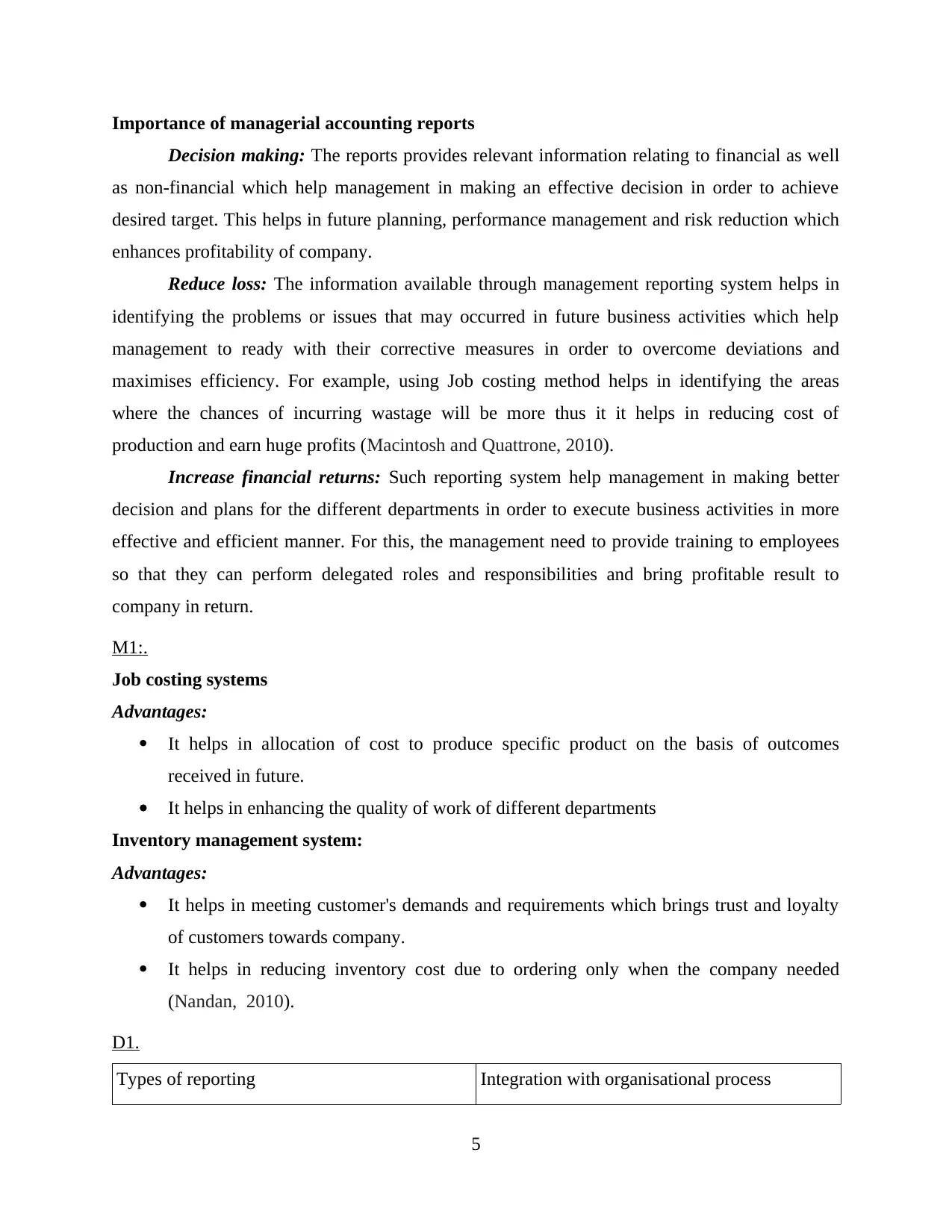
Importance of managerial accounting reports
Decision making: The reports provides relevant information relating to financial as well
as non-financial which help management in making an effective decision in order to achieve
desired target. This helps in future planning, performance management and risk reduction which
enhances profitability of company.
Reduce loss: The information available through management reporting system helps in
identifying the problems or issues that may occurred in future business activities which help
management to ready with their corrective measures in order to overcome deviations and
maximises efficiency. For example, using Job costing method helps in identifying the areas
where the chances of incurring wastage will be more thus it it helps in reducing cost of
production and earn huge profits (Macintosh and Quattrone, 2010).
Increase financial returns: Such reporting system help management in making better
decision and plans for the different departments in order to execute business activities in more
effective and efficient manner. For this, the management need to provide training to employees
so that they can perform delegated roles and responsibilities and bring profitable result to
company in return.
M1:.
Job costing systems
Advantages:
It helps in allocation of cost to produce specific product on the basis of outcomes
received in future.
It helps in enhancing the quality of work of different departments
Inventory management system:
Advantages:
It helps in meeting customer's demands and requirements which brings trust and loyalty
of customers towards company.
It helps in reducing inventory cost due to ordering only when the company needed
(Nandan, 2010).
D1.
Types of reporting Integration with organisational process
5
Decision making: The reports provides relevant information relating to financial as well
as non-financial which help management in making an effective decision in order to achieve
desired target. This helps in future planning, performance management and risk reduction which
enhances profitability of company.
Reduce loss: The information available through management reporting system helps in
identifying the problems or issues that may occurred in future business activities which help
management to ready with their corrective measures in order to overcome deviations and
maximises efficiency. For example, using Job costing method helps in identifying the areas
where the chances of incurring wastage will be more thus it it helps in reducing cost of
production and earn huge profits (Macintosh and Quattrone, 2010).
Increase financial returns: Such reporting system help management in making better
decision and plans for the different departments in order to execute business activities in more
effective and efficient manner. For this, the management need to provide training to employees
so that they can perform delegated roles and responsibilities and bring profitable result to
company in return.
M1:.
Job costing systems
Advantages:
It helps in allocation of cost to produce specific product on the basis of outcomes
received in future.
It helps in enhancing the quality of work of different departments
Inventory management system:
Advantages:
It helps in meeting customer's demands and requirements which brings trust and loyalty
of customers towards company.
It helps in reducing inventory cost due to ordering only when the company needed
(Nandan, 2010).
D1.
Types of reporting Integration with organisational process
5
Paraphrase This Document
Need a fresh take? Get an instant paraphrase of this document with our AI Paraphraser
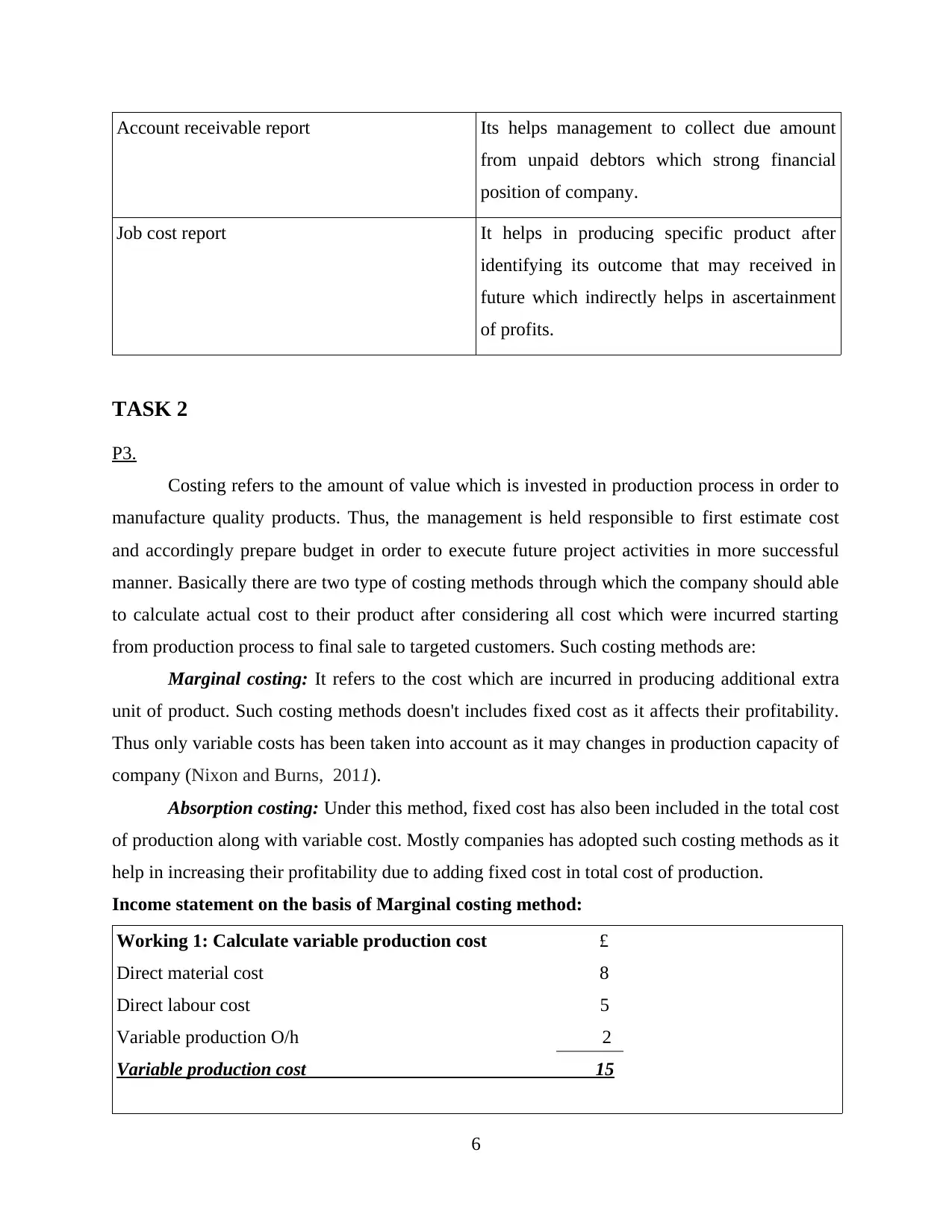
Account receivable report Its helps management to collect due amount
from unpaid debtors which strong financial
position of company.
Job cost report It helps in producing specific product after
identifying its outcome that may received in
future which indirectly helps in ascertainment
of profits.
TASK 2
P3.
Costing refers to the amount of value which is invested in production process in order to
manufacture quality products. Thus, the management is held responsible to first estimate cost
and accordingly prepare budget in order to execute future project activities in more successful
manner. Basically there are two type of costing methods through which the company should able
to calculate actual cost to their product after considering all cost which were incurred starting
from production process to final sale to targeted customers. Such costing methods are:
Marginal costing: It refers to the cost which are incurred in producing additional extra
unit of product. Such costing methods doesn't includes fixed cost as it affects their profitability.
Thus only variable costs has been taken into account as it may changes in production capacity of
company (Nixon and Burns, 2011).
Absorption costing: Under this method, fixed cost has also been included in the total cost
of production along with variable cost. Mostly companies has adopted such costing methods as it
help in increasing their profitability due to adding fixed cost in total cost of production.
Income statement on the basis of Marginal costing method:
Working 1: Calculate variable production cost £
Direct material cost 8
Direct labour cost 5
Variable production O/h 2
Variable production cost 15
6
from unpaid debtors which strong financial
position of company.
Job cost report It helps in producing specific product after
identifying its outcome that may received in
future which indirectly helps in ascertainment
of profits.
TASK 2
P3.
Costing refers to the amount of value which is invested in production process in order to
manufacture quality products. Thus, the management is held responsible to first estimate cost
and accordingly prepare budget in order to execute future project activities in more successful
manner. Basically there are two type of costing methods through which the company should able
to calculate actual cost to their product after considering all cost which were incurred starting
from production process to final sale to targeted customers. Such costing methods are:
Marginal costing: It refers to the cost which are incurred in producing additional extra
unit of product. Such costing methods doesn't includes fixed cost as it affects their profitability.
Thus only variable costs has been taken into account as it may changes in production capacity of
company (Nixon and Burns, 2011).
Absorption costing: Under this method, fixed cost has also been included in the total cost
of production along with variable cost. Mostly companies has adopted such costing methods as it
help in increasing their profitability due to adding fixed cost in total cost of production.
Income statement on the basis of Marginal costing method:
Working 1: Calculate variable production cost £
Direct material cost 8
Direct labour cost 5
Variable production O/h 2
Variable production cost 15
6
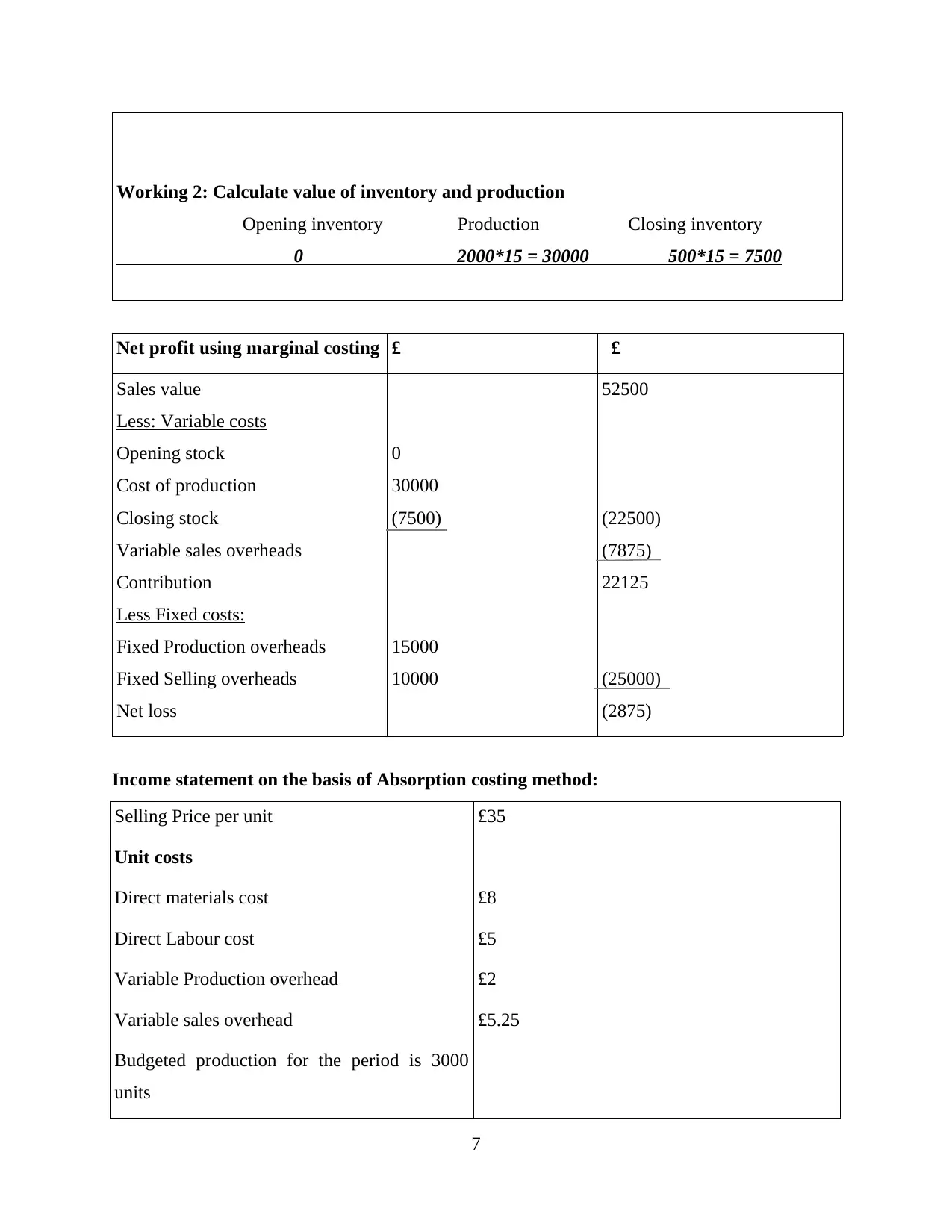
Working 2: Calculate value of inventory and production
Opening inventory Production Closing inventory
0 2000*15 = 30000 500*15 = 7500
Net profit using marginal costing £ £
Sales value
Less: Variable costs
Opening stock
Cost of production
Closing stock
Variable sales overheads
Contribution
Less Fixed costs:
Fixed Production overheads
Fixed Selling overheads
Net loss
0
30000
(7500)
15000
10000
52500
(22500)
(7875)
22125
(25000)
(2875)
Income statement on the basis of Absorption costing method:
Selling Price per unit £35
Unit costs
Direct materials cost £8
Direct Labour cost £5
Variable Production overhead £2
Variable sales overhead £5.25
Budgeted production for the period is 3000
units
7
Opening inventory Production Closing inventory
0 2000*15 = 30000 500*15 = 7500
Net profit using marginal costing £ £
Sales value
Less: Variable costs
Opening stock
Cost of production
Closing stock
Variable sales overheads
Contribution
Less Fixed costs:
Fixed Production overheads
Fixed Selling overheads
Net loss
0
30000
(7500)
15000
10000
52500
(22500)
(7875)
22125
(25000)
(2875)
Income statement on the basis of Absorption costing method:
Selling Price per unit £35
Unit costs
Direct materials cost £8
Direct Labour cost £5
Variable Production overhead £2
Variable sales overhead £5.25
Budgeted production for the period is 3000
units
7
⊘ This is a preview!⊘
Do you want full access?
Subscribe today to unlock all pages.

Trusted by 1+ million students worldwide
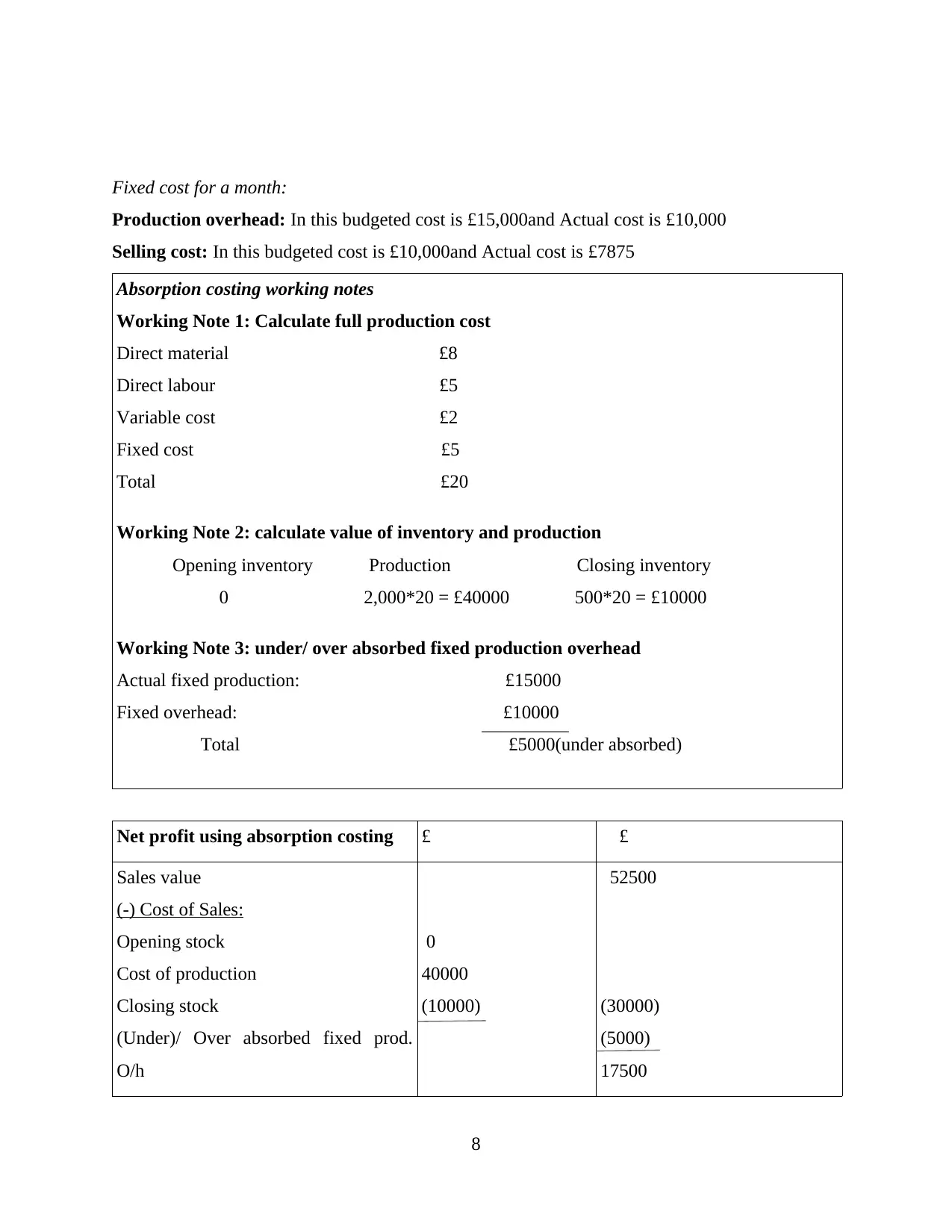
Fixed cost for a month:
Production overhead: In this budgeted cost is £15,000and Actual cost is £10,000
Selling cost: In this budgeted cost is £10,000and Actual cost is £7875
Absorption costing working notes
Working Note 1: Calculate full production cost
Direct material £8
Direct labour £5
Variable cost £2
Fixed cost £5
Total £20
Working Note 2: calculate value of inventory and production
Opening inventory Production Closing inventory
0 2,000*20 = £40000 500*20 = £10000
Working Note 3: under/ over absorbed fixed production overhead
Actual fixed production: £15000
Fixed overhead: £10000
Total £5000(under absorbed)
Net profit using absorption costing £ £
Sales value
(-) Cost of Sales:
Opening stock
Cost of production
Closing stock
(Under)/ Over absorbed fixed prod.
O/h
0
40000
(10000)
52500
(30000)
(5000)
17500
8
Production overhead: In this budgeted cost is £15,000and Actual cost is £10,000
Selling cost: In this budgeted cost is £10,000and Actual cost is £7875
Absorption costing working notes
Working Note 1: Calculate full production cost
Direct material £8
Direct labour £5
Variable cost £2
Fixed cost £5
Total £20
Working Note 2: calculate value of inventory and production
Opening inventory Production Closing inventory
0 2,000*20 = £40000 500*20 = £10000
Working Note 3: under/ over absorbed fixed production overhead
Actual fixed production: £15000
Fixed overhead: £10000
Total £5000(under absorbed)
Net profit using absorption costing £ £
Sales value
(-) Cost of Sales:
Opening stock
Cost of production
Closing stock
(Under)/ Over absorbed fixed prod.
O/h
0
40000
(10000)
52500
(30000)
(5000)
17500
8
Paraphrase This Document
Need a fresh take? Get an instant paraphrase of this document with our AI Paraphraser
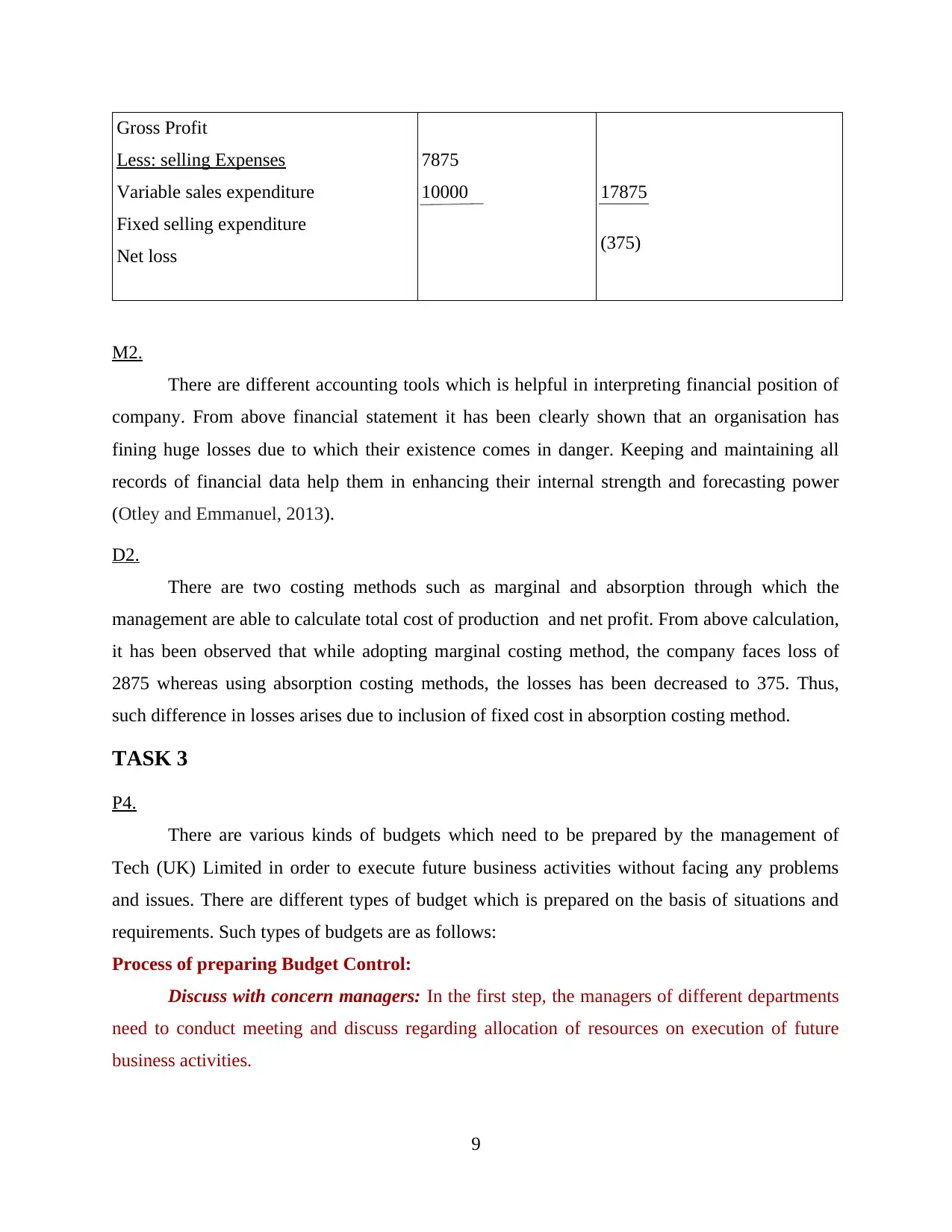
Gross Profit
Less: selling Expenses
Variable sales expenditure
Fixed selling expenditure
Net loss
7875
10000 17875
(375)
M2.
There are different accounting tools which is helpful in interpreting financial position of
company. From above financial statement it has been clearly shown that an organisation has
fining huge losses due to which their existence comes in danger. Keeping and maintaining all
records of financial data help them in enhancing their internal strength and forecasting power
(Otley and Emmanuel, 2013).
D2.
There are two costing methods such as marginal and absorption through which the
management are able to calculate total cost of production and net profit. From above calculation,
it has been observed that while adopting marginal costing method, the company faces loss of
2875 whereas using absorption costing methods, the losses has been decreased to 375. Thus,
such difference in losses arises due to inclusion of fixed cost in absorption costing method.
TASK 3
P4.
There are various kinds of budgets which need to be prepared by the management of
Tech (UK) Limited in order to execute future business activities without facing any problems
and issues. There are different types of budget which is prepared on the basis of situations and
requirements. Such types of budgets are as follows:
Process of preparing Budget Control:
Discuss with concern managers: In the first step, the managers of different departments
need to conduct meeting and discuss regarding allocation of resources on execution of future
business activities.
9
Less: selling Expenses
Variable sales expenditure
Fixed selling expenditure
Net loss
7875
10000 17875
(375)
M2.
There are different accounting tools which is helpful in interpreting financial position of
company. From above financial statement it has been clearly shown that an organisation has
fining huge losses due to which their existence comes in danger. Keeping and maintaining all
records of financial data help them in enhancing their internal strength and forecasting power
(Otley and Emmanuel, 2013).
D2.
There are two costing methods such as marginal and absorption through which the
management are able to calculate total cost of production and net profit. From above calculation,
it has been observed that while adopting marginal costing method, the company faces loss of
2875 whereas using absorption costing methods, the losses has been decreased to 375. Thus,
such difference in losses arises due to inclusion of fixed cost in absorption costing method.
TASK 3
P4.
There are various kinds of budgets which need to be prepared by the management of
Tech (UK) Limited in order to execute future business activities without facing any problems
and issues. There are different types of budget which is prepared on the basis of situations and
requirements. Such types of budgets are as follows:
Process of preparing Budget Control:
Discuss with concern managers: In the first step, the managers of different departments
need to conduct meeting and discuss regarding allocation of resources on execution of future
business activities.
9
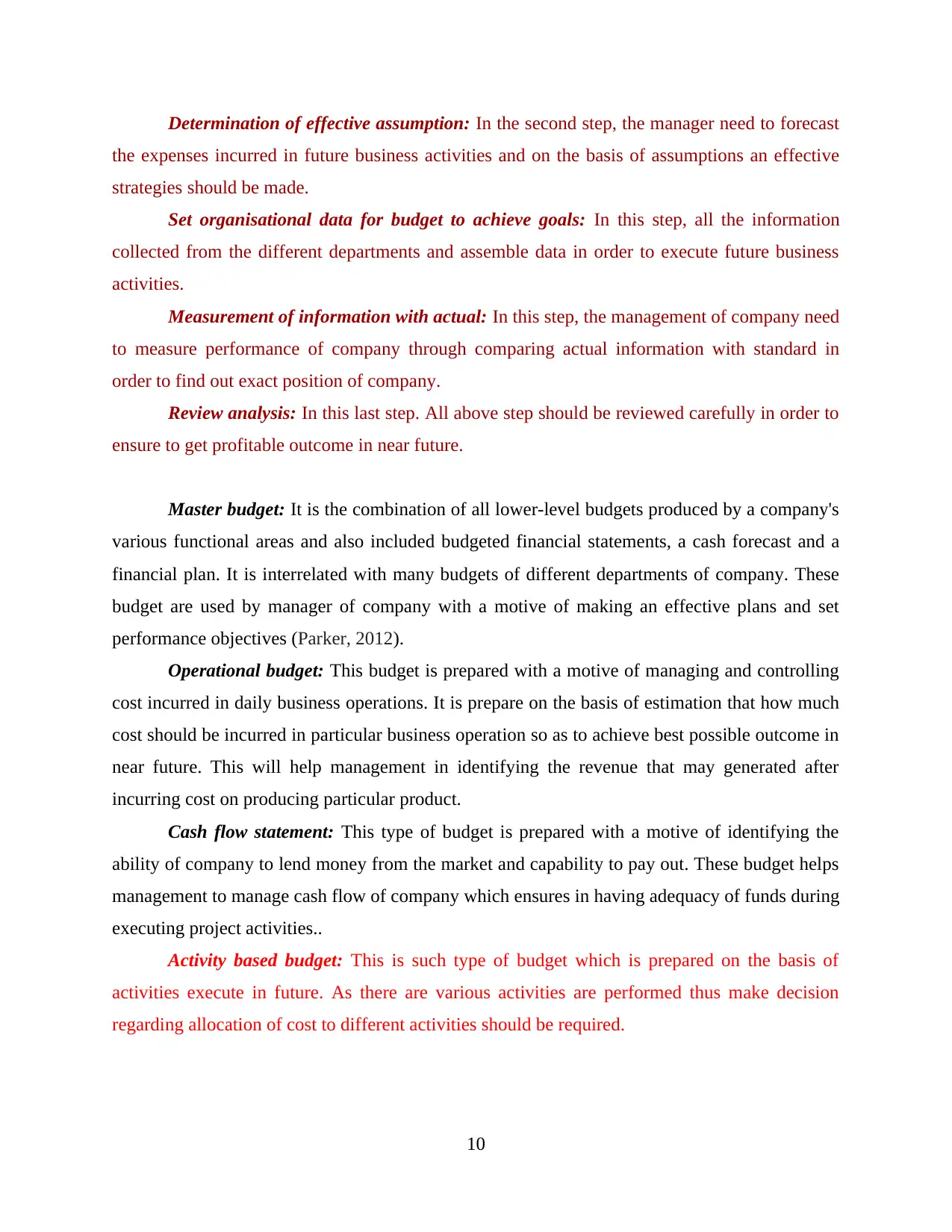
Determination of effective assumption: In the second step, the manager need to forecast
the expenses incurred in future business activities and on the basis of assumptions an effective
strategies should be made.
Set organisational data for budget to achieve goals: In this step, all the information
collected from the different departments and assemble data in order to execute future business
activities.
Measurement of information with actual: In this step, the management of company need
to measure performance of company through comparing actual information with standard in
order to find out exact position of company.
Review analysis: In this last step. All above step should be reviewed carefully in order to
ensure to get profitable outcome in near future.
Master budget: It is the combination of all lower-level budgets produced by a company's
various functional areas and also included budgeted financial statements, a cash forecast and a
financial plan. It is interrelated with many budgets of different departments of company. These
budget are used by manager of company with a motive of making an effective plans and set
performance objectives (Parker, 2012).
Operational budget: This budget is prepared with a motive of managing and controlling
cost incurred in daily business operations. It is prepare on the basis of estimation that how much
cost should be incurred in particular business operation so as to achieve best possible outcome in
near future. This will help management in identifying the revenue that may generated after
incurring cost on producing particular product.
Cash flow statement: This type of budget is prepared with a motive of identifying the
ability of company to lend money from the market and capability to pay out. These budget helps
management to manage cash flow of company which ensures in having adequacy of funds during
executing project activities..
Activity based budget: This is such type of budget which is prepared on the basis of
activities execute in future. As there are various activities are performed thus make decision
regarding allocation of cost to different activities should be required.
10
the expenses incurred in future business activities and on the basis of assumptions an effective
strategies should be made.
Set organisational data for budget to achieve goals: In this step, all the information
collected from the different departments and assemble data in order to execute future business
activities.
Measurement of information with actual: In this step, the management of company need
to measure performance of company through comparing actual information with standard in
order to find out exact position of company.
Review analysis: In this last step. All above step should be reviewed carefully in order to
ensure to get profitable outcome in near future.
Master budget: It is the combination of all lower-level budgets produced by a company's
various functional areas and also included budgeted financial statements, a cash forecast and a
financial plan. It is interrelated with many budgets of different departments of company. These
budget are used by manager of company with a motive of making an effective plans and set
performance objectives (Parker, 2012).
Operational budget: This budget is prepared with a motive of managing and controlling
cost incurred in daily business operations. It is prepare on the basis of estimation that how much
cost should be incurred in particular business operation so as to achieve best possible outcome in
near future. This will help management in identifying the revenue that may generated after
incurring cost on producing particular product.
Cash flow statement: This type of budget is prepared with a motive of identifying the
ability of company to lend money from the market and capability to pay out. These budget helps
management to manage cash flow of company which ensures in having adequacy of funds during
executing project activities..
Activity based budget: This is such type of budget which is prepared on the basis of
activities execute in future. As there are various activities are performed thus make decision
regarding allocation of cost to different activities should be required.
10
⊘ This is a preview!⊘
Do you want full access?
Subscribe today to unlock all pages.

Trusted by 1+ million students worldwide
1 out of 18
Related Documents
Your All-in-One AI-Powered Toolkit for Academic Success.
+13062052269
info@desklib.com
Available 24*7 on WhatsApp / Email
![[object Object]](/_next/static/media/star-bottom.7253800d.svg)
Unlock your academic potential
Copyright © 2020–2025 A2Z Services. All Rights Reserved. Developed and managed by ZUCOL.





